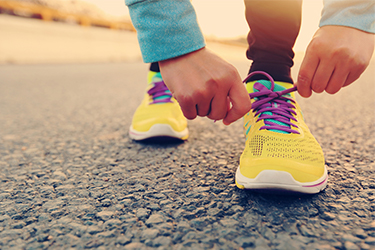
Athletic Shoes – So Many Choices, But Which One Is Right For You?
- Posted on:
- Posted in: Health
When it comes to fitness shoes, how do you search for the fit, the use, the style, the color, the brand? From walking to running to working out to cross-training to playing tennis, to playing basketball and other activities, there are hundreds of choices in today’s hot fitness shoe market.
History of the fitness shoe
Since 1839, when Charles Goodyear invented the process for molding rubber that could be shaped and applied to many substances including rubber shoe soles, it was the English who finally designed the first athletic shoe made for playing croquet. Soon, U.S. company Converse started making shoes for basketball players, followed by another new company, Adidas, that focused on running (track) and soccer shoes in 1924. By the 1950s, “sneakers” became all the rage. And so the industry grew.
Potential health problems from wearing the wrong athletic shoe
Philip R. Yearian DPM, Puget Sound Orthopaedics Podiatrist and Foot and Ankle surgeon advises athletes of all levels and regardless of the activity to not make one pair of athletic shoes work for all types of use. “Wearing the wrong pair of shoes can cause many injuries to the body,” he says. “A shoe that isn’t made for a specific activity, such as running for instance, can create hip, knee and back pain and lead to injuries such as shin splints, blisters, or plantar fasciitis.”
Runner’s World seven tips to get the proper fit in a running shoe
1 ) Heel. Your heel should feel snug but not tight and allow for some heel movement.
2 ) Instep. You should feel secure around your instep with the upper shoe feeling snug and secure but not tight.
3 ) Width. While standing, the shoe’s width should allow the foot to move side-to-side. A shoe is too narrow if your little toe sits on the edge of the shoe last.
4 ) Length. Your toes should be able to freely wiggle to prevent foot issues. While standing, make sure there’s a thumb width of space between your longest toe and where the heel ends.
5 ) Flex. The shoe should bend along the same line your foot flexes to avoid arch pain.
6 ) Feel. Find a shoe that match your foot’s contours and movements when you stand. Try them out in the store to make sure the arch support is comfortable. The shoe should match your stride, not vice versa.
7 ) Fit. Don’t shop for shoes just because they look good or are fashionable. Buy for fit.
For more information about the history of athletic shoes or finding the correct fitness shoe visit the following websites:
American Academy of Orthopaedic Surgeons
https://orthoinfo.aaos.org/en/search/?q=athletic+shoes
Runners World
https://www.runnersworld.com/running-shoes/how-to-buy-the-right-running-shoes
The Humble History of the Sneaker
https://www.heddels.com/2014/12/humble-history-sneaker/
By Holly Harmon for Puget Sound Orthopaedics
SHARE


